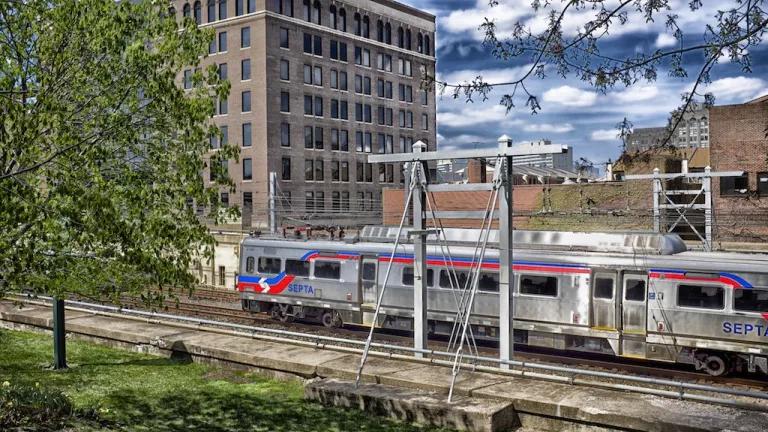
My answer to the question of whether to measure carbon pollution from local and state transportation plans asked in a notice of proposed rulemaking by U.S. DOT today and covered by Politico reporter Mike Grunwald is YES. It reminds me of a saying in carpentry: “Measure twice, cut once.” This is common sense. A cut is hard to fix if you get it wrong.
Unfortunately many cities, counties and states haven’t inventoried or set standards for the carbon pollution from transportation plans twice—or even once. Yet projects within them can lock us into a future of ever-increasing pollution, even as our cars and trucks get cleaner on average thanks to impressive fuel economy performance standards. It makes sense to measure the impacts of major, multi-year transportation plans for metropolitan regions and states.
Thankfully, some government agencies are taking an interest in measuring results of their plans. The trend has been dubbed the “holy grail of public leadership.” Public health, energy and educational initiatives today are assessed using metrics. We are measuring both prospectively (based on what’s planned) and retrospectively (based on what actually happened).
In the energy efficiency area, for example—a growing, multi-billion dollar field—investments are increasingly subject to comprehensive prospective cost-effectiveness testing and later evaluation, monitoring and verification of results, known as “E, M & V”. In this arena, we can learn from what our City Energy Project is finding with large commercial buildings. There’s a lot of energy wasted in these buildings, but often no baseline for “benchmarking” performance over time. The term “benchmarking” originally referred to chiseled arrow marks in stone structures made by determining where a leveling rod should be placed in the future. Now it’s often used to describe performance metrics used to assess progress over time, or in comparison to peers or a common standard.
The transportation sector eats up a lot more money. But it lags way behind energy efficiency in results-based accountability. To be fair, there are some transportation-related “performance-based accountability systems” (PBASs), as a Rand Corporation monograph described them in 2010. But it’s hard to say where these actually apply in practice—as the analysts dryly noted: “We were unable to find for this study transportation programs that incorporated PBASs…” A more recent report by the Congressional Budget Office (CBO) confirms this lack of accountability, finding that, “Spending on highways does not correspond very well with how the roads are used and valued.” CBO recommended three possible remedies for investing federal dollars more effectively ($46 billion on highways alone in 2014), including performance management for transportation plans.
Enter Moving Ahead for Progress in the 21st Century, or MAP-21, the 2012 transportation law. Its landmark planning provisions were inspired in part by policy recommendations of the Bipartisan Policy Center, in their report, Performance Driven: A New Vision for U.S. Transportation Policy. Under these provisions, “transportation decisionmaking” will now require a “performance-based approach.” Consequently, the U.S. Department of Transportation has, for the first time, started developing rules and standards for performance management by grantees (metropolitan planning organizations—MPOs—and state transportation agencies). This is excellent progress, as those grantees receive billions of our taxpayer dollars a year.
A key area where transportation plans should include standards is measurement of air pollution, including greenhouse gases. After all, our transportation law planning objectives include “minimizing transportation-related fuel consumption and air pollution through metropolitan and statewide transportation planning…” (P.L. 109-59) as well as “enhanc[ing] the performance of the transportation system while protecting and enhancing the natural environment.” (P.L. 112-141).
Here’s the good news: several MPOs and states already incorporate, as a best practice, managing the greenhouse gas pollution performance of their transportation plans. The biggest example is California and its 18 MPOs, which have been inventorying greenhouse gas pollution from transportation for several years, pursuant to a state law. The state highway agency also has a specific metric for “[P]ercent reduction of transportation system-related air pollution for greenhouse gas emissions” in its current 5-year strategic plan. These local and state transportation agencies have also set targets for reducing those emissions.
Similarly, the Oregon Department of Transportation is also tasked with collaborating with its 6 MPOs to inventory and reduce greenhouse gas pollution from transportation.
Across the country, Massachusetts has a state regulation requiring its department of transportation to demonstrate achievement of transportation pollution reduction targets. It also requires “metropolitan planning organizations (MPOs) to evaluate and track the GHG emissions and impacts of Regional Transportation Plans and Transportation Improvement Programs…” NRDC preliminary research found several other MPOs that inventory greenhouse gas emissions in their regional transportation plans including the Chicago Metropolitan Agency for Planning, the Puget Sound Regional Council and the Metropolitan Council (in Minnesota).
This best practice should be the rule for all state and local transportation agencies, and the simple truth is that we need to benchmark greenhouse gas pollution in transportation plans if we are serious about reaching our national climate goals. Let’s get to work.



